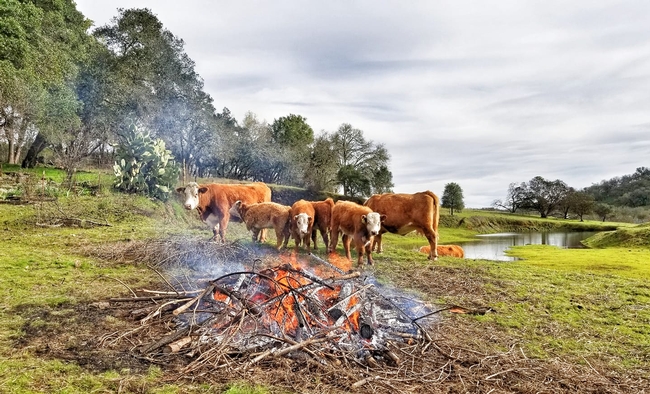Valuable forage for livestock and wildlife is often lost on rangelands after wildfires. What should landowners, affected by recent fires, do to migrate the impacts to their rangelands - oak savannas, chaparrals and woodlands, which have undoubtedly lost grass production from recent fires?
The effect the fire has on the resulting vegetation and production can vary based on the timing and intensity of the fire, and the quality, quantity and type of forage and subsequent rainfall.
Estimating Loss
Estimating the cost of such losses cannot be based on traditional grazing rental rates for livestock because the impact of forage production is more for ranching than the impact of grazing. All residual dry matter (RDM) is removed with fire, and the soil profile is disturbed. In addition to the loss of forage, the next 2 years of forage production could be impacted along with the length of adequate forage-growing periods and species competition.
University of California Cooperative Extension (UCCE) publication 8446 Estimating the Cost of Replacing Forage Losses on Annual Rangeland can be downloaded free of charge to assist with calculating ranch losses and help reporting to the USDA Farm Service Agency (FSA). A UCCE advisor can assist with completing forage loss calculations and reporting requirements to FSA. In addition, the Natural Resources Conservation Service (NRCS) offers financial assistance in the form of a cost share (EQIP) for reseeding rangeland. This program is valuable because it provides enough financial help to make the practice economical.
When calculating losses most often the equivalent in hay is considered in monetizing the forage loss value (1 ton of forage lost = the cost of a ton of hay). USDA releases a weekly Direct Hay Report that can be used to determine the cost of replacement forage. This is usually the most practical method, but there are other costs to consider.
Assistance from the FSA and NRCS can assist landowners in replacing forage loss, livestock, and fences. Check with our local FSA county office to make sure that all production acreage is on file so that it is covered, and that all applicable programs are signed up for. In many cases, there are deadlines to file for assistance that are put in place once losses occur.
Seeding
A fire, one occurring late summer or early fall, can burn the RDM remaining following the grazing season. With RDM burned, there is a higher chance of erosion after the first rains, especially if early rains are heavy. Erosion control is essential to prevent or control water and soil erosion on lands, especially those with steeper slopes. Effective erosion control techniques will inhibit surface runoff and are important measures to prevent water pollution and soil loss.
The type of seeding depends on your resource goals. If you want to reseed following a fire, contact our UCCE office to assist in designing the most appropriate mix. Site conditions, management, and rainfall vary between properties which can change appropriate seeding recommendations. It is worth getting this part right, otherwise the effort may be wasted. It is generally recommended to use a blend containing a mix of annuals, which will germinate early and assist with holding the soil, along with perennials which are long lived grasses that are productive, but require specific management for success.
Seeding is best be done immediately prior to fall rains as grass fires don't provide enough ash for broadcasted seed to make good seed to soil contact allowing for seed to be adequately covered. No till drilling seed is best or if broadcasting, cover the seed with a harrow after broadcasting. Broadcast seeding too early can results in birds eating the seed prior to germination. Flying seed on with an airplane should be done just prior to rain.
If an establishment of desirable forage species already existed, seeding may not be necessary since grass fires that occur in summer or later should have little effect on mature seed laying on the soil surface. This would negate much of the benefit in seeding; however, production will still be less due to the lack of soil cover, particularly if it's a dry winter. Fires that occurred in higher brush densities can get hot enough to affect seed on the soil surface. Their advantage is that they do provide a nutrient rich seed bed and source of cover for seed to fall into. Reseeding these areas can be successful by dropping seed into the white ash. Because weed competition is usually eliminated by these hot fires, and fertility is high, these seedings have been successful in the past.
Hydro Seeding
Hydro seeding (or hydraulic mulch seeding, hydro-mulching, hydra seeding) is a planting process that uses a slurry of seeds and mulch. It is often used as an erosion control technique on construction sites, as an alternative to the traditional process of broadcasting or sowing dry seed, or on recently burned areas, on sites that have high erosion potential following a fire.
Links
- UCCE Sonoma email: cesonoma@ucanr.edu
- NRCS Petaluma office: (707) 794-1242 ext 107
- FSA Petaluma office: (707) 664-8593
